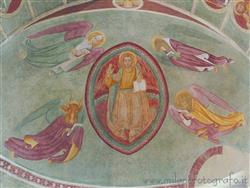|
Church of San Siro alla Vepra
|
|
|
Show an other treasure of art and history in Milan:
|
 Mostly represented styles: Romanesque - Gothic Mostly represented styles: Romanesque - Gothic
The Church of San Siro alla Vepra has very ancient origins, it being already mentioned in a document of 885.
What survived up to the present day, however, is the apse of the church that was built in the mid-fifteenth century, between 1454 and 1465, in Lombard Gothic style with still Romanesque elements near the Solarian style.
In 1483 the church was purchased by the Pecchi family, who remained owners until ca. mid-nineteenth century.
During the seventeenth century the Pecchi demolished the front part of the building, while keeping the back part with the three apses. It was at that time that on the right side of the church to the courtyard a pointed arch door was added, which is still present today.
In 1911 the chapel was declared a national monument, in spite the serious state of neglect in which it poured.
In 1927 the remaining parts of the oratory were restored by the owner Temistocle Fossati, who let the architect Zanchi built the villa in neo-Renaissance style which is now attached to the church.
The villa became infamous during the last World War, as the headquarters of the notorious gang Koch, paramilitary group of the Republic of Salò. Hence the nickname "Villa Triste" ("Sad Villa").
After the end of the war, the Fossati did not want to go back to the villa.
The complex formed by the villa and the church are now the headquarters of the Missionary Sisters of the Immaculate.
Since the mid 80s of last century several other restoration works were made, the last ones just in 2012.
Of the church remains, as mentioned, only the absidale part. The central and the right apse are semicircular, the left one, however, has a rectangular plan. Each apse is illuminated by a single window. Those of the central and of the right apse are particular for the fact of being single-light round arch windows inside a pointed arch frame.
The round section apses are decorated with pilasters, while under all roofs there is a white frame.
What remains of the body of the church has a gabled roof.
An interior structural peculiarity is the fact that the central apse is round-arched, but it is preceded by an arch with an acute angle. At the junction between them there is therefore a step of varying height.
All apses are decorated with frescoes.
Those in the main apse are probably of 1468. In the vault there is a Christ Pantocrator enclosed in a colorful almond and seated on a rainbow.
Around him four figures symbolizing the evangelists (the angel = Matthew, the eagle = John, the lion = Mark, the ox = Luke).
At the center of the wall of the apse there is a crucifixion between the Virgin and John the Evangelist.
To the left there are furthermore St. John the Baptist with the lamb sitting on top of the book, St. Peter Martyr, with an ax stuck in the head, the Archangel Gabriel, with the weight scale to weigh the souls and the sword to hold off the demon at his feet, and, finally, the Saints Cosmas and Damian, recognizable by the doctor's tools in their hands.
On the right, the Saints Ambrose and Siro, patrons of Milan and of Pavia.
The inner surface of the arch in front of the apse is decorated with medallions depicting the apostles.
On the wall of the left apse there is a Madonna and Child between the Saints Ambrose and Augustine. On top Godfather in the act of handing out a crown to the Virgin Mary. The fresco was made in 1522.
In the right apse, finally, there are geometric and plant decorations.
Worthy of mention, finally, the holy water, of the early Christian epoch and consisting of an upturned lid of a small sarcophagus for children.
If you are interested in a guided tour of this monument send an email!
Categories: Churches / Religious buildings
Via Masaccio 20 - S. Siro, Milano (MI) |
Further pictures of the Church of San Siro alla Vepra in the section Photography |